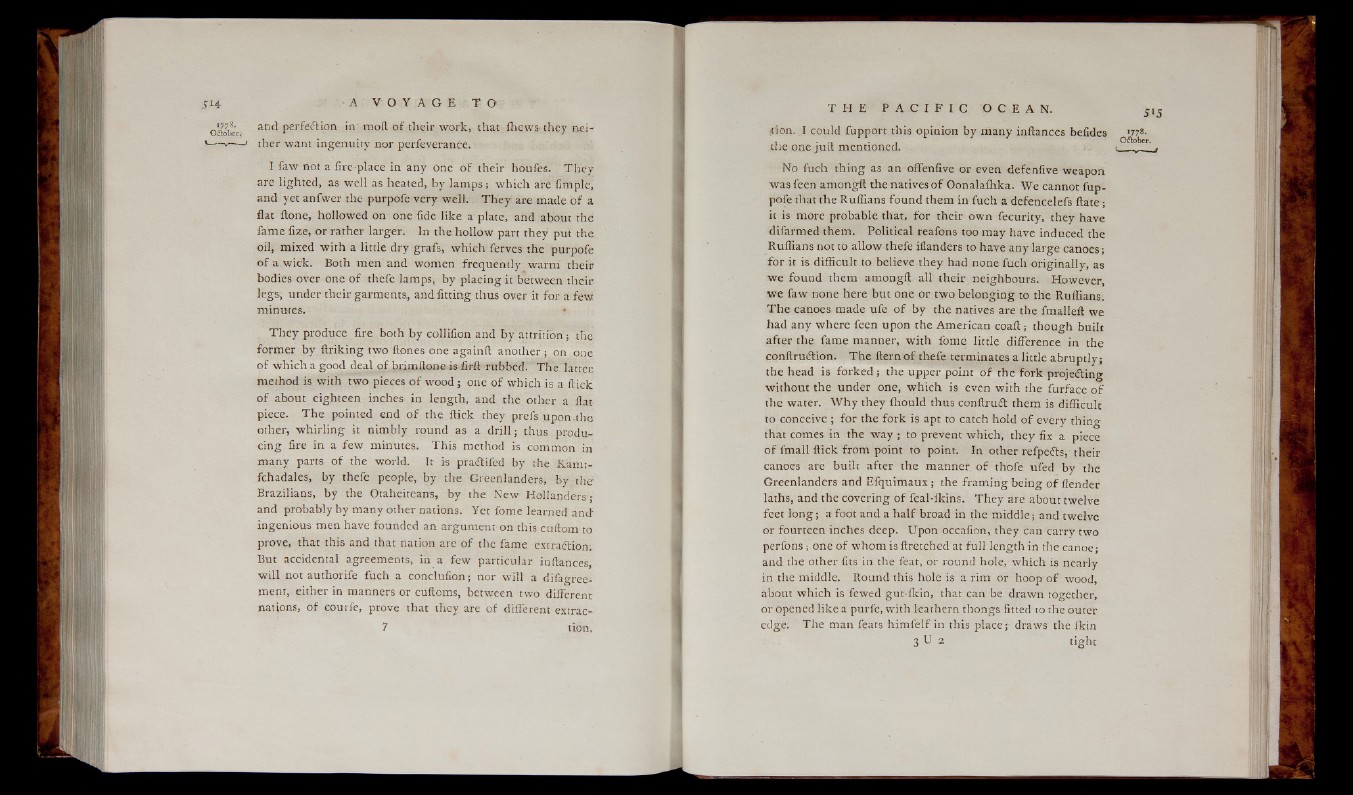
oaoife’r- and perfection in' mod o f their work, that fhcws they nei-
1 ther want ingenuity nor perfeverance.
I faw not a fire-place in any one o f their houfes. T h e y
are lighted, as well as heated, by lam p s ; which are fimple,
and yet anfwer the purpofe very well. T h e y are made o f a
flat ftone, hollowed on one fide like a plate, and about the
fame fize, or rather larger. In the hollow part they put the
oil, mixed with a little dry grafs, which ferves the purpofe
o f a wick. Both men and women frequently warm their
bodies over one o f thefe lamps, by placing it between their
legs, under their garments., and fitting thus over it for a few
minutes. •
T h e y produce fire both by collifion and by attrition ; the
former by ftriking two flones one againfl another ; on one
o f which a good deal o f b rimilone is firft rubbed. The latter
method is with two pieces o f wood ; one o f which is a flick
o f about eighteen inches in length, and the other a flat
piece. T he pointed end o f the flick they prefs upon the
other, w hirlin g it nimbly round as a d r ill; thus producin
g fire in a few minutes. This method is common in
many parts o f the world. It is praelifed by the Kamt-
fchadales, by thefe people, by the Greenlanders, by the
Brazilians, b y the Otaheiteans, by the New Hollanders',-
and probably by many other nations. Yet fome learned and:
ingenious men have founded an argument on this cuftom to
prove, that this and that nation are o f the fame extraction.
But accidental agreements, in a few particular inftances,
w ill not authorife fuch a conclufion; nor will a difagree-
ment, either in manners or cuftoms, between two different
nations, o f courfe, prove that th e y are o f different extrac-
7 tion.
<ion. I could fupport this opinion by many inftances befides i|g&
the one ju ft mentioned. — ' f
No fuch thing as an offenfive or even defenfive weapon
was feen amongft the natives o f Oonalafhka. We cannot fup-
pofe that the Ruffians found them in fuch a defencelefs ftate ;
it is more probable that, for their own fecurity, they have
difarmed them. Political reafons too may have induced the
Ruffians not to allow thefe iflanders to have any large canoes;
fo r it is difficult to believe they had none fuch originally, as
w e found them amongft all their neighbours. However,
w e faw none here but one or two belonging to the Ruffians.
T h e canoes made ufe o f by the natives are the fmalleft we
had any where feen upon the American coaft; though built
after the fame manner, w ith fome little difference in the
conftruclion. T he fte rn o f thefe terminates a little abruptly;
the head is forked ; the upper point o f the fork projecting
without the under one, which is even with the furface o f
the water. W h y they ihould thus conftruCt them is difficult
to conceive ; for the fork is apt to catch hold o f every thing
that comes in the w ay ; to prevent which, they fix a piece
o f fmall ftick from point to point. In other refpeCls, their
canoes are builc after the manner o f thofe ufed by the
Greenlanders and Efquimaux ; the framing being o f flender
laths, and the covering o f feal-ikins. T h e y are about twelve
feet lo n g ; a foot and a h a lf broad in the middle; and twelve
or fourteen inches deep. Upon occafion, they can carry two
perfons ; one o f whom is ftretched at fu ll length in the canoe;
and the other fits in the feat, or round hole,- which is nearly
in the middle. Round this hole is a rim or hoop o f wood,
about which is fewed gut-ikin, that can be drawn together,
or opened like a purfe, with leathern thongs fitted to the outer
edge. The man fears h im fe lf in this place;' draws the fkin
3 u 2 tight.